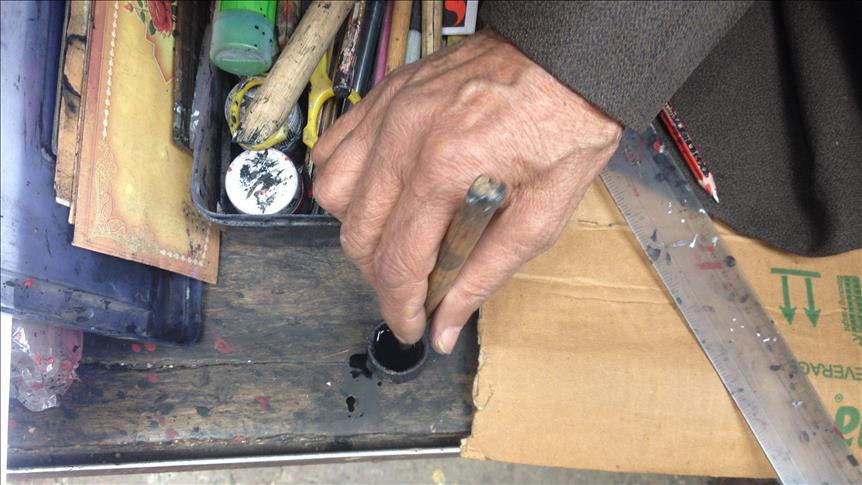A dying art: Indian calligraphy in the digital age
In an increasingly digitalized world, the centuries-old art of Indian calligraphy faces threat of extinction

India
By Zahid Rafiq
NEW DELHI
The ink appears to be drying for the centuries-old art of traditional Indian calligraphy.
As calligraphers find themselves in competition with an increasingly digitalized world, it is only a matter of time, they say, before the art disappears altogether.
Old Delhi’s iconic Urdu Bazaar, the city’s publishing hub at one time, is now a rundown mishmash of garment shops and cheap bistros, where about half a dozen of the city’s remaining calligraphers are the last practitioners of a dying trade.
The oldest of them, 72-year-old Mohammad Tahsin, sits on a wooden bench at the entrance of a narrow lane. His assortment of pens, inks and other calligraphy paraphernalia lie by his side in a canvas bag, waiting -- like him -- for increasingly elusive customers.
"There was a time when I had no time to eat or sleep, there was so much work," says Tahsin. "Now, there’s a customer every two or three days. Sometimes I wonder if my memories of being flooded with work are even real."
Tahsin had his last customer four days ago. Since then, he has been waiting -- an art at which, he says, he has become as good at as he has at calligraphy.
In the 1960s, Tahsin, a high school dropout, was fascinated with the beauty of calligraphy and learned the art on his own. He began working as a calligrapher in the Urdu Bazaar in 1968.
"I was 25 then. There was work of every kind. There were no computers at that time; we did all the writing," he recalls.
"We did the work at the newspapers, for books; we made the political posters, invitation cards, religious posters; we did the writing on the film posters; we made the receipt books, the letterheads. We had a hundred different kinds of work," he says.
Tahsin can do calligraphy in four different languages: Urdu, Persian, English and Hindi. But even this full quiver of languages hasn’t helped his dying business.
With the advent of computers and printers -- with their sophisticated myriad of colors and fonts -- traditional calligraphers found themselves swept to the side.
‘Extinct’
Not far from the Urdu bazar is Mohammad Showkat’s small, multi-purpose shop, which boasts a computer, a printer, a Xerox machine and a camera. Many of the customers who would have once gone to calligraphers now come here.
"What they [calligraphers] do in two hours, I can do in two minutes -- and at a much lower price," says Showkat. "Their work is outdated; it’s an extinct animal. There is no way it can survive in this world where I can print out a thousand sheets in five minutes."
Showkat says that, while he has respect for the calligraphers, he can’t imagine a way for their trade to survive.
"It can be an art in today’s world, but it can’t be a trade," he says. "You can’t turn back the clock."
Two decades ago, Tahsin recalls, there were around a dozen calligraphers like him in the Urdu Bazaar, most of whom had employees working for them.
"Now I’m the oldest calligrapher here while the youngest is in his mid-50s," he says. "In the last two decades, no young men have taken up the trade because there isn’t enough work to go around."
Tahsin says it is only his passion for the art that keeps him going -- and the fact that he no longer has any dependents and can therefore survive on the little money he still makes each month.
A short distance from Tahsin’s wooden bench is a small bookshop, where Mohammad Yaqub has practiced calligraphy for decades.
Yaqub, 62, a calligrapher for over 30 years, also laments the long wait for customers.
Tahseen, Yaqub and the other calligraphers now eke out a living making receipt books for mosques, providing calligraphy for government-issued stamps and -- every now and then -- they are sought out for hand-written marriage documents.
"But it’s hardly any money," says Yaqub. "Within a few years, all of us will be gone."
Anadolu Agency website contains only a portion of the news stories offered to subscribers in the AA News Broadcasting System (HAS), and in summarized form. Please contact us for subscription options.







